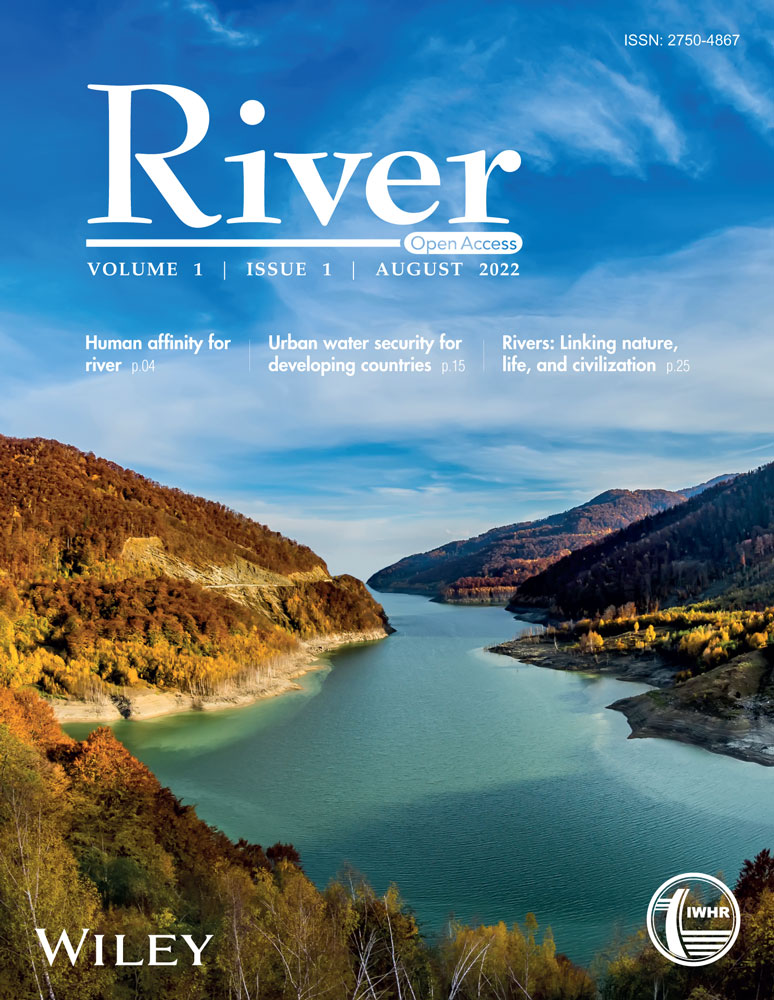A review on effects of human activities on aquatic organisms in the Yangtze River Basin since the 1950s
Abstract
The Yangtze River is the longest river in China, with abundant water resources, high water energy reserves, and rich biodiversity. Human activities have greatly changed the hydrology and ecology of the Yangtze River Basin since the 1950s. The aquatic biodiversity in the Yangtze River Basin has declined sharply, while the amount of fishery in the Yangtze River has been maintained due to higher intense of fishing, artificial proliferation intervention, and other factors. Human activities including overfishing, water polluting, damming, reclaiming wetlands, shipping and shoreline development, species introduction, and so forth have had great influence on aquatic ecosystems. This paper also reviewed the measures implemented to protect the aquatic ecosystems of the Yangtze River. By reviewing the evolutionary trend of aquatic organisms in the Yangtze River Basin and the related human activities, this paper helps to better understand the biodiversity of the Yangtze River, and requires more attention on the continuous impact of human activities, as well as the effectiveness of protection measures under the new situation of Yangtze River protection.
1 INTRODUCTION
The world's large rivers and their floodplains are now home to approximately 2.7 billion people (Best, 2019). The functions of river in the process of urban development include water sources, transportation, sewage discharge, waterlogging drainage, and urban defense, which ensure the stability of the city, and promote the agglomeration of the population and the prosperity of industry and commerce (Wantzen et al., 2016). In industrial society, rivers played more important roles in providing industrial, agricultural, and domestic water, shipping, and sewage disposal. At the same time, rivers also provide more energy and aquaculture resources. In recent decades, the ecological and landscape functions of rivers have gradually received increasing attention (Zheng et al., 2020). Freshwater habitats support approximately 10% of all known species, and one-third of vertebrate species (Strayer & Dudgeon, 2010). However, freshwater fishes are the fastest-extinct vertebrate species globally (Burkhead, 2012). People have begun to re-examine the relationships between human activities and rivers from the perspective of rivers providing ecosystem services and maintaining the stability of natural and artificial ecosystems. The development and utilization of rivers and River Basin resources have shifted to a sustainable approach. China has achieved rapid industrialization in just a few decades, while Western countries took hundreds of years (Huang, 2018). The characteristics and problems of various periods of industrialization development are concentrated in China, especially in areas with dense populations and rapid social and economic development.
The Yangtze River is the largest river in China, with a trunk length of approximately 6300 km and a watershed area of approximately 1.8 million km2, accounting for 18.8% of China's land area. The Yangtze River Basin has a developed water system, with more than 7000 tributaries directly flowing into the Yangtze River, and 437 tributaries with watershed areas greater than 1000 km2. The Yangtze River Basin is an important economic zone in China, with a total population of 459 million, accounting for approximately 33.0% of the nation. The GDP of the basin was 29.3 trillion yuan (4.34 trillion dollars) in 2017, accounting for 35.4% of the national total. The Yangtze River Basin is rich in water, with an annual average water resource of 995.9 billion m3 (Z. Wang et al., 2011). The Yangtze River is also one of the rivers with the most abundant hydropower resources, and the theoretical reserves of water energy resources are approximately 268 million kW, of which 197 million kW is technically exploitable (Cui, 2017). The Yangtze River Basin is one of the regions with the richest biodiversity in China and all over the world. Human activities in the Yangtze River Basin have increased rapidly since the 1950s. The Chinese government has constantly adjusted its development philosophy, and environmental protection and ecological progress have gradually become the main stream of society. In 2016, the Outline of the Development Plan for the Yangtze River Economic Belt was released, marking a new stage of green development for the Yangtze River. On the basis of summarizing the changes in human activities and biodiversity in the Yangtze River Basin in recent decades, this study examined the measures and effects of biodiversity conservation in the basin, providing a reference for the sustainable development of the Yangtze River Basin (Figure 1).
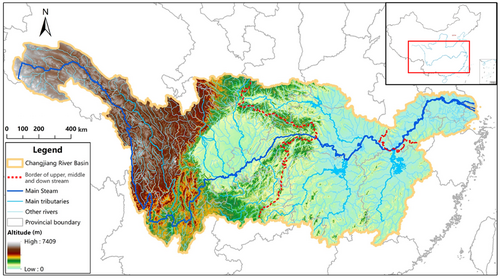
2 EVOLUTIONARY TREND OF AQUATIC ORGANISMS IN THE YANGTZE RIVER BASIN SINCE THE 1950S
2.1 Evolutionary trend of aquatic biodiversity
The understanding on aquatic biodiversity in the Yangtze River Basin is in progress. Foreign and domestic scholars have carried out fish surveys in some areas of the Yangtze River since the late 19th century. In 1954, the Chinese government organized the first survey of aquatic biodiversity in the whole Yangtze River Basin. After more than 10 years of research, 206 fish species were recorded and their classification and distribution in the Yangtze River were described. Combined with historical records, 274 species of fish were reported in the Yangtze River Basin, including 170, 153, and 142 in the upper, middle, and lower reach, respectively, and more than 60 species present in the upper, middle, and lower reaches (Fish Laboratory of Hubei Hydrobiology Institute, 1976). In the 1970s, the Chinese government organized the fishery resource survey of the Yangtze River. The results showed that there were 370 fish species in the Yangtze River, including 209, 215, 129, and 126 species in the upper reach, middle reach, lower reach, and the estuary, respectively, and 78 species in all reaches (The Investigation Team of Fisheries Resources in the Yangtze River, 1990). Ye et al. (2011) sorted 416 fish species (including subspecies) in the Yangtze River based on published literature, including 14 species in the river source region, 279 species in the upper reach, 227 species in the middle reach, 158 species in the lower reach, and 142 species in the estuary. According to a review of latest literature, 485 fish species (including subspecies) were recorded in the Yangtze River Basin, with 20, 267, 221, 173, and 147 species in the river source region, upper reach, middle reach, lower reach, and the estuaries, respectively, and 102 species across the upper, middle, and lower reaches. In addition to fish, there are 298 known species of aquatic plants (Z. Wu et al., 2019), 1033 benthic species and genera (He et al., 2019), and approximately 2000 species of plankton (MEE et al., 2018) in the Yangtze River.
Due to the differences among investigators, the scope of investigation, sampling time, sampling frequency, and sampling method, as well as other factors, the results of aquatic biodiversity surveys cannot be compared directly. However, it is generally accepted that the aquatic biodiversity of the Yangtze River has declined sharply. Some common species with historical distributions have become rare, and the number of species has shown a gradual decline in repeated surveys. For example, although the number of fish species recorded in the middle reach of the Yangtze River exceeded 200, only 59 species of fish had been detected by three fishery monitoring stations from 2001 to 2003 (S. Liu et al., 2005). Fish stock survey of the main stream of National Nature Reserve of Rare and Endemic Fish in the Upper Yangtze River from 2010 to 2012 showed a declining trend of fish resources, and approximately 1/3 of historical recorded fish species were not detected during the survey (Gao et al., 2013). More than 110 species of fish were recorded in Dongting Lake, but only approximately 80 species were found in multiple surveys after 2010 (Jiang et al., 2019). A total of 212 species of fish was recorded in the Poyang Lake Basin before 2000, but 37.7% of indigenous fish species and 36.7% of migratory fish species disappeared from 2000 to 2017, and the number of fish species decreased to 174 (X. Liu et al., 2019). At the same time, the number of threatened species in the Yangtze River Basin continues to increase, and the degree of threat is increasing. In the 1990s, 27 fish species distributed in the Yangtze River Basin were assessed as endangered (EN) species according to Yue and Chen (1998). In the 2000s, 50 species of fish in the Yangtze River Basin were assessed as threatened species (S. Wang & Xie, 2009), including 3 critically endangered (CR), 27 EN, and 16 vulnerable (VU) species. In the 2010s, 90 out of 405 inland fish species in the Yangtze River Basin were threatened, including 22 CR, 40 EN, and 28 VU (MEP & CAS, 2015).
Among the threatened aquatic organisms in the Yangtze River, the Baiji (Lipotes vexillifer), the Yangtze finless porpoise (Neophocaena asiaeorientalis), and the Chinese sturgeon (Acipenser sinensis) are the species most concerned. In 2007, Baiji was considered to have completely lost its ability to survive and reproduce in the natural environment of the Yangtze River, and was declared functionally extinct (Turvey et al., 2007). No trace of Baiji has been found since the 2000s. In the 1990s, there were more than 2000 finless porpoises in the Yangtze River Basin, while in 2017, the number dropped to 1012. In 2018, the Yangtze finless porpoise was proved to be an independent species in the Yangtze River Basin, and its threat level was adjusted from EN to CR (Zhou et al., 2018). After the closure of Gezhouba, the number of breeding populations of Chinese sturgeon detected in the Yangtze River increased for a short time, peaked around 1990 (approximately 2200), and then declined rapidly, with only approximately 170 remaining in 2010 (L. Wang et al., 2018). No signs of spawning and breeding of Chinese sturgeon have been detected since 2013, with the exception of 2016 (Yangtze River Fisheries Administration MARA, etc., 2020). In addition, Chinese paddlefish (Psephurus gladius) has been considered functionally extinct (H. Zhang et al., 2019).
2.2 Evolutionary trend of aquatic biological resources
Fishery resources in the Yangtze River Basin include more than 50 species, most of which are fish, as well as some aquatic plants, macrobenthic invertebrates, amphibians, and reptiles (The Investigation Team of Fisheries Resources in the Yangtze River, 1990). The fishery resources differ greatly among the upper, middle and lower reaches of the Yangtze River due to the differences in habitats. In the upper reach, commercial fishes are mainly composed of species adapted to the rapid current, including Coreius heterodon, C. guichenoti, Rhinogobio typus, R. Ventralis, R. cylindrical, Procypris rabaudi, Spinibarbus sinensis, Onychostoma sima, Garra pingi, Myxocyprinus asiaticus, and so forth (W. Xu et al., 2012). In the middle reach, commercial fishes are mainly adapted to slow flow or still water, including “Four Major Carp Species (FMCS)” (black carp [Mylopharyngodon piceus], grass carp [Ctenopharyngodon idella], silver carp [Hypophthalmichthys molitrix], and bighead carp [Aristichthys nobilis]), and Elopichthys bambusa, Luciobrama macrocephalus, Ochetobius elongatus, Squaliobarbus curriculus, Parabramis pekinensis, Megalobrama terminalis, Chanodichthys mongolicus, Culter alburnus, Xenocypris davidi, X. microlepis, and so forth (S. Liu et al., 2005). In the lower reach and estuary, fishery resources mainly include migratory fish, such as Coilia ectenes, C. mystus, Hemisalanx prognathus, Tenualosa reevesii, pufferfish (Takifugu spp.), eel (Anguilla japonica), and Chinese mitten crab (Eriocheir sinensis) (Shi et al., 2009).
Since the 1960s, the fishery resources in the Yangtze River Basin have been seriously degraded. The number of economic fish has decreased, the dominant species have changed, and the proportion of old fish have decreased, while the proportion of young fish and juvenile fish have increased; and the natural fish fry have been depleted. For example, in the upper reach of the Yangtze River, there were more than 50 species of commercial fish in the 1960s, which decreased to less than 40 species in the mid-1970s; and further decreased to approximately 20 species in the 1990s (D. Chen, 2003). In the 1960s and 1970s, C. heterodon and C. Guichenoti accounted for more than 40% of the catch in the upper reach of the Yangtze River, but decreased to approximately 20% in the 1990s (Qiu et al., 1998). Large fish (mainly carp [Cyprinus carpio], the FMCS, and mandarin fish [Siniperca chuatsi]) accounted for approximately 60% of the catch of Honghu Lake during the 1950s−1960s, but small fish (including crucian [Carassius auratus], yellow catfish [Pelteobagrus spp.], Cultrichthys erythropterus, Hemiculter leucisculus, and so forth) accounted for almost 90% since the 1980s (M. Zhu et al., 2008). After the impoundment of the Three Gorges Reservoir, the proportions of carp (C. carpio), silver carp, and catfish (Silurus spp.), which prefer slow flow or still water, increased significantly and became the main fishing objects in the Three Gorges Reservoir (S. Liu et al., 2005). Besides, the amount of fishing in the main stream of the Yangtze River around the 2010s was only 1% of that in the 1950s (State Environmental Protection Administration, 2003−2018). In recent years, the early stage fish resources in the middle reach have gradually recovered due to the implementation of a series of protective measures, such as the ecological regulation to promote the natural breeding of the FMCS (Zhou et al., 2019) and the releasing of broodstock fishes (J. Wang et al., 2014). The runoff eggs of the FMCS in 2017−2018 increased by about 13 times compared with the 2000s (C. Chen et al., 2020).
Although the fishery resources in the Yangtze River Basin have declined significantly, fishery production was not seriously affected due to increased fishing intensity, changes in fishing objects, artificial proliferation, and other factors. After the low point from the 1960s to the 1980s, the amount of fishing rebounded rapidly, reaching the top of 1.65 million tons in 2003 (Figure 2). Afterward, with the implementation of the fishing ban in the Yangtze River Basin, catch production decreased, but basically remained above 1 million tons. In 2016, the Outline of the Development Plan for the Yangtze River Economic Belt was issued, and the fishing industry gradually withdrew from the Yangtze River Basin, resulting in a rapid decline in the fishing amount. In July 2016, over 10,000 tons of cultured sturgeon escaped from floods in the middle reach of the Yangtze River. Fishermen were encouraged to fish to reduce the impact of cultured sturgeon on Chinese sturgeon and other protected species, resulting in a 50% increase in the fishing amount in Hubei Province in 2017. At the same time, the development of artificial breeding technology resulted in the expansion of the aquaculture fishery scale in the Yangtze River Basin, and the proportion of the output of the fishing industry decreased year by year (Figure 3), which also virtually alleviated the pressure of claiming the natural fishery resources of the Yangtze River.
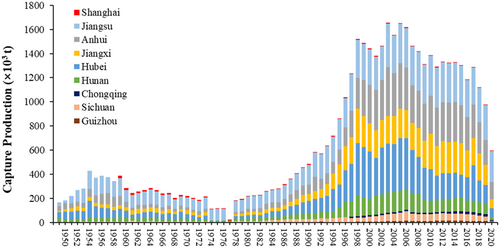
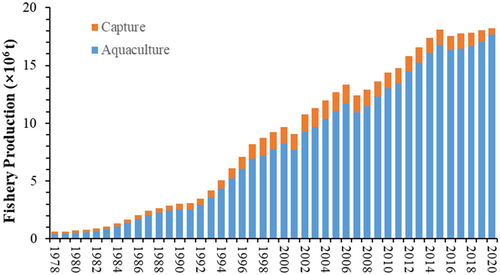
3 THE MAIN HUMAN ACTIVITIES AFFECTING AQUATIC BIODIVERSITY
The factors affecting aquatic biodiversity and resources in the Yangtze River Basin include overfishing, habitat loss, fragmentation and destruction, invasive species, and so forth. These activities that are closely related to human activities, have made contributions to the economic development of the Yangtze River Basin, but have also had negative impacts on the aquatic biodiversity of the Yangtze River.
3.1 Overfishing
Overfishing is the main reason for the decline of aquatic biodiversity in the Yangtze River Basin. Fishing activities directly or indirectly affect fishery resources. The direct effects include selective fishing of some target species, resulting in changes in their growth rate, mortality, fecundity, and replenishment. Indirect effects are mainly reflected in the capture of some nontarget objects; or changes in the habitat status of fish, resulting in changes in the biomass, species composition, predator−prey relationship, age, and body length structure of fish communities (Hobday et al., 2011). The economic development of the Yangtze River Basin has promoted the development of the fishing industry. The number of motorized fishing boats registered in the Yangtze River Basin reached nearly 300,000 in the early 2010s, with a total tonnage of 1.45 million tons, which were 163 and 70 times of those in 1979 respectively, and the number of personnel specializing in fishing remained above 30,000 for years (Bureau of Fisheries MARA, 1979−2021). At the same time, fishing gear is constantly updated, and commonly used gear include gill nets, ground cages, purse seines, trawl nets, electric fishing machines, and so forth. In addition, the application of nylon and other materials increases the life of fishing nets and actually increases the fishing time (H. Wang et al., 2019).
Before the implementation of the fishing ban policies in the Yangtze River Basin, fishing activities were carried out throughout the year, and the fishing intensity had far exceeded the carrying capacity of fish resources (H. Zhang et al., 2020). The decrease of fishery resources led to higher intensity of fishing. The Chinese government had formulated fishery management laws to make activities such as electric fishing, fishing with poison, blasting rivers to catch fish, fishing with fine mesh net, fishing in protected area, and fishing during ban seasons illegal since 1986. However, illegal fishing activities have not stopped, and the mesh of the fishing gear has become finer and finer. A total of 34,600 cases of illegal electric fishing were solved in the Yangtze River Basin during 2014 and 2017, with an average annual increase of 8.8% (General Office of the National Audit Office of the People's Republic of China, 2018). Reeves shad (T. reevesii) has been considered functionally extinct due to overfishing and other factors (H. Jiang et al., 2009). Great quantities of large commercial fishes, such as the FMCS, are caught when they are not sexually mature, and their dominance in the catch has been replaced by small-shaped species, such as yellow catfish and crucian carp (W. Liu & Cao, 1992). In addition, the problems of miniaturization and younger age of fish catch are prominent. In the middle reaches of the Yangtze River, 1-year-old fish and 2-year-old fish of most species accounted for more than 70% of the catch (S. Liu et al., 2005). Fishermen in Poyang Lake and lower reaches use nets specifically designed to catch the juveniles of coilia, and the weights of caught individuals are generally less than 10 g.
3.2 Human activities related habitat loss, fragmentation, and destruction
The population in the Yangtze River Basin has doubled since the 1950s, and the economic aggregate has increased thousands of times. Rapid population and economic growth requires lots of resources, and the intensity of development in the Yangtze River Basin continues to increase. High intensity human activities, including water pollution, damming, wetland reclamation, channelization, and so forth, result in the habitat loss, fragmentation, and destruction of aquatic organisms. Consequently, the biodiversity in Yangtze River Basin has been seriously affected.
3.2.1 Water polluting
In the 1960s to the 1990s, industrial wastewater and domestic sewage were discharged directly into the Yangtze River. The pollution discharge increased from 9.5 billion t/a in the late 1970s, to 15 billion t/a in the late 1980s, and 20 billion t/a in the mid-to-late 1990s (G. Yang et al., 2007). The pollution sources were mainly concentrated in cities along the river such as Chongqing, Wuhan, Nanjing, Shanghai, and so forth. Pollutants include heavy metals such as mercury, chromium, tin, copper, lead, and zinc, as well as non-metals such as arsenic, fluorine, phosphorus, phenol, cyanide, organic chlorine, organic phosphorus, and other organic pollutants (Wan, 1989). At the same time, the increase in the use of pesticides and fertilizers and the increase in domestic sewage discharge led to a rapid increase in the phosphorus concentration in the Yangtze River (Hu et al., 2020). Due to the large amount of water and the large environmental capacity of the Yangtze River (Y. Wang et al., 2020), the water pollution problem in most of the main reaches of the Yangtze River was not serious except for a few sections.
Since the 1990s, the economic development of the Yangtze River Basin has accelerated, and the discharge of sewage and wastewater increased year by year. As a result, the water environment has undergone tremendous changes. The proportion of river lengths with different water quality grades in the Yangtze River Basin after 1998 (Changjiang Water Resources Commission, 1998−2018; MEE, 2020, 2021) were analyzed in this paper. In China, water quality is divided into six grades, Grades I and II represent high-quality water, Grade Ⅲ represents good water quality, Grade IV represents poor water quality, Grade V represents bad water quality, and Grade inferior to V represents the worst water quality. The water quality of the whole basin decreased before 2009 and gradually increased thereafter (Figure 6). The trends of water pollution in the Yangtze River Basin before 2009 were mainly manifested in the increase of sewage discharge, the diversification of major pollutant types, the increase in pollutant concentration, the gradual spread of polluted areas from tributaries and a few main river sections to most areas of the basin, and the increase of proportion in the poor-quality water bodies. In 2009, the water quality of nearly 7000 km of reaches was classified as inferior to Grade V, accounting for 15.0% of the total river lengths evaluated; rivers of Grade IV and Grade V were nearly 10,000 km in length, accounting for 21.3%; and rivers with high-quality and good-quality water accounted for only 63.7%. Due to the isolation of rivers and lakes, the pollution of lakes in the Yangtze River Basin was more serious than that of rivers. The water quality of Dianchi Lake had completely degraded to the inferior to Grade V since the 1990s (Hou et al., 2019). The water quality of Taihu lake was Grade Ⅲ in the 1980s, but degraded to Grade V and Grade inferior to V in the 1990s (C. Li et al., 2019). The concentration of pollutants in lake siltation are much higher than that in water bodies; for example, heavy metal concentrations are 1000−100,000 times higher than those in water bodies (Yi et al., 2011). These pollutants accumulate through the aquatic ecosystem food chain, posing a significant threat to ecosystem stability, and human health. Incidents caused by water pollution have occurred frequently. In 2000, chemical plants in the upper reaches of the Dadu River, which is a large tributary in the upper reach of the Yangtze River, illegally discharged highly toxic sludge and phosphorus-containing wastewater, and directly caused the death of more than 480 tons of fish (D. Chen, 2003). In 2004, the pollution of the Tuojiang River, which is another large tributary in the upper reach of Yangtze River, resulted in the interruption of drinking water for millions of residents in the basin and the death of more than 500 tons of fish (Ding, 2007). Water blooms frequently occur in Dianchi Lake, Chaohu Lake, Taihu Lake, and other lakes (Le et al., 2010).
In 2011, the Chinese government issued the “Water pollution prevention and control plan in the middle and lower reaches of the Yangtze River (2011−2015),” and invested 45.981 billion yuan. The water pollution in the Yangtze River Basin was gradually controlled. In 2015, the Chinese government issued the “Water Pollution Prevention and Control Action Plan” to continuously strengthen water pollution control in the basin, and the water quality of the Yangtze River Basin was further improved. In 2018, the ammonia nitrogen concentration in the lower reaches of the Yangtze River Basin decreased by approximately 65% compared with 2012, and the total phosphorus concentration in the upper reaches decreased by 45%−60% (B. Lou et al., 2020). In 2020, the proportion of Grade I−Ⅲ water bodies in the Yangtze River Basin have reached 96.6%, and Grade V and inferior to V water have been basically eliminated.
3.2.2 Damming
The first large-scale hydropower station in the Yangtze River Basin was built in 1954, and the development of water conservancy in the Yangtze River Basin has accelerated since 1958. By 1980, a total of 38,800 reservoirs and 2500 hydropower stations had been built in the Yangtze River Basin (Editorial Committee of the First National Water Conservancy Census Results Series, 2017). These reservoirs and hydropower stations have various functions such as flood control, power generation, water supply, irrigation, shipping, and aquaculture, which have greatly promoted the economic construction and social development of the Yangtze River Basin and China (J. Liu et al., 2013). Later, the focus of water conservancy construction in the Yangtze River Basin turned to hydropower development, and a number of large reservoirs and hydropower stations were built after 2000. Among them, 11 hydropower stations have been built on the main steam, and 6 are under construction (Figure 4). As of 2020, 52,800 reservoirs have been built in the Yangtze River Basin, with a total storage capacity of 365.8 billion m,3 and more than 25,000 hydropower stations have been built (MWR Ministry of Water Resources, 2021), with an annual power generation of over 600 billion kWh. The Yangtze River hydropower energy saves China more than 200 million tons of coal each year, which is equivalent to a reduction of 730 million tons of CO2 emissions. In addition to power generation, these water conservancy projects have also played important roles in flood control. When the Yangtze River flooded in 2020, the reservoirs in the upper and middle reaches of the Yangtze River accumulated 49.2 billion m3 of floodwater, including 25.4 billion m3 in the Three Gorges Reservoir. Consequently, Jingjiang Flood Division Aera in the middle reach escaped from being inundated, and over 600,000 people as well as 40,000 hm2 farmland within were protected from floods (Huang et al., 2021).
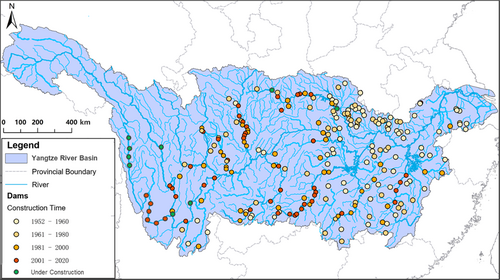
While bringing large contributions to social and economic benefit, dams and reservoirs have also changed the natural form and runoff of the Yangtze River (J. Wu et al., 2004). The rivers have been blocked, and the continuity has been reduced. The control of the discharge flow significantly changed the process of downstream runoff, resulting in flattening characteristics (Bunn & Arthington, 2002). The shapes of the natural rivers have been changed, and the enlarged water body areas have changed the local precipitation and evaporation (Nilsson et al., 2005). The self-purification capacity of the water body has been reduced (Silva et al., 2005), and a large amount of deposited pollutants has also intensified eutrophication in the reservoir area (Sun et al., 2017). As a result, the original fish habitat area has declined, and spawning, hatching, and migration of fish have been affected. Instead, fish that prefer still water becomes dominant in the community, and the total biomass may increase due to larger water area. After the Three Gorges Reservoir was impounded, approximately 660 km of flowing water upstream of the dam site shifted to a slow-flowing environment, fish preferring flowing water environments became occasional species (J. Liu et al., 2013; Lin et al., 2019). The annual amount of catch in the Three Gorges Reservoir gradually declined from over 3000 tons to less than 2000 tons in the early 2000s, but increased rapidly afterward. By the late 2010s, the annual amount of catch has increased to over 7000 tons (State Environmental Protection Administration, 2003−2018) and the proportion of fish that prefer still water increased (Z. Yang et al., 2015). The discharge from high dams also causes supersaturation of dissolved gas in the downstream water body and led to fish death. For example, in 2014, flood discharge from the Xiluodu Hydropower Station caused the death of more than 40 tons of fish downstream (Y. Wang et al., 2020).
In addition, the construction of the reservoir has changed the flow regime and sediment transportation (Changjiang Water Resources Commission, 2022; Fu et al., 2003), affecting the habitat of aquatic organisms. The spawning signals for the FMCS disappeared or weakened due to the impoundment of the Three Gorges Reservoir, lead to the resource decline in the middle reach, however, this effect could be alleviated by ecological reservoir reoperation (Yi et al., 2010). The ecological reservoir reoperation during FMCS spawning season has implemented since 2011, and received significant effects. The consideration of other species and other reservoirs could be extended in future. The sediment load decrease in downstream of dam is another problem should be considered (Figure 5b). The scouring of the downstream of the reservoir has changed the shape of the river channel, this may result in the destruction of sandbars, shoals and other habitats in the river channel (Q. Xu et al., 2011), and shrunk of fish spawning grounds (Bai et al., 2014). After the impoundment of the Three Gorges Reservoir, the flood and sediment entering Dongting Lake continued to decrease, and the sedimentation changed to scour (X. Zhang et al., 2010), which is beneficial to prolonging the life of Dongting Lake. On the other hand, the Three Gorges Reservoir's impounding after the flood season also lowers the water stage of the Dongting Lake, and makes the dry season coming about a month ahead (Fang et al., 2014). The Yangtze Estuary also has experienced sediment starvation since the impoundment of the Three Gorges Reservoir, as a result, the accretion of coastal salt marsh decreased (S. L. Yang et al., 2011).
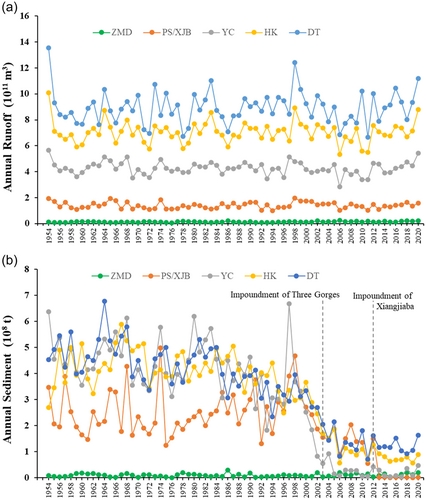
Consequently, how to satisfy fish habitat requirement by reservoir operation, to make the most of the advantages of reservoir on ecology are still a hot topic in recent years.
3.2.3 Reclaiming wetlands
Compared with the 1950s, by 2000, more than 10,000 km2 of lakes in the middle and lower reaches of the Yangtze River Basin were reclaimed as farmland, and the area of lakes on the Jianghan Plain had decreased by 58% (Du et al., 2011). Meanwhile, many sluices have been built in the middle and lower reaches of the Yangtze River for flood management, irrigation, and other purposes. The sluices block the connection between lakes and the Yangtze River, as well as the circulation of aquatic organisms (X. Liu & Wang, 2010). Many fish in the Yangtze River Basin, including are migratory between rivers and lakes, spawning in running water and fattening in still water bodies such as lakes or river bays. Due to the isolation of rivers and lakes, domestic fish in the lakes fail to enter the Yangtze River to spawn, and the domestic fish resources in the main stream cannot be fully replenished. At the same time, it is difficult for the fry in the Yangtze River to enter the lakes, further aggravating the decline of the fishery resources in the Yangtze River Basin, especially the FMCS (S. Liu et al., 2005). At present, only a few lakes in the middle and lower reaches of the Yangtze River, such as Dongting Lake, Poyang Lake, and Shijiu Lake, are still connected to the Yangtze River (C. Chen et al., 2020). These lakes have also become the only important refuges for aquatic organisms in the middle and lower reaches of the Yangtze River.
3.2.4 Shipping and shoreline development
The main channel of the Yangtze River runs from Yunnan Province to the estuary of the Yangtze River, with a total length of 2838 km. The tributary channels include the Jialing River, Wujiang River, Minjiang River, Dongting Lake river system, Poyang Lake river system, and other waterways. There are 4296 production berths in the ports along the main stream of the Yangtze River (Z. Yang et al., 2015). The waterway management department has implemented a series of projects to ensure the operation of shipping and reduce the risk of shipping accidents, for example, the Yangtze River Estuary Deep Water Channel Construction Project, the 12.5 m Deep Water Channel Construction below Nanjing Project, the Jingjiang Channel Renovation Project, the Yibin-Chongqing Class Ⅲ Channel Renovation Project, and so forth (J. Liu, 2015). River channels have been dredged and deepened, and cut to be straight. Riverbanks have been hardened. Riverbeds and reefs have been cleaned, and so forth. Most of these areas are habitats for fish and aquatic organisms. Meanwhile, with the increase in the navigable capacity of the Yangtze River, the density of ships has increased continuously, reducing the spaces for aquatic organisms in the river channel. As a result, the Yangtze finless porpoise and other larger aquatic organisms are VU to ship propellers. Studies have showed that ships cause more than 50% of the abnormal deaths of Yangtze finless porpoises (F. Wu et al., 2014).
The diverse habitats near riverbanks are important habitats for many aquatic organisms to inhabit and reproduce, and the construction of ports and riverbank slope protection works have directly changed riparian habitats, resulting in the loss of habitats for a variety of small fish and benthic organisms. At present, approximately 38.6% of the shoreline of the main stream of the Yangtze River has been developed and utilized. The main types of development include agriculture, industry and ports, and the degree of development gradually increases from upstream to downstream. The upstream, middle and downstream agricultural development coastlines account for 5.4%, 28.3%, and 17.9%, respectively; the industrial development coastlines account for 4.3%, 7.3%, and 16.1%, respectively; and the port development coastlines account for 4.9%, 7.4%, and 15.4%, respectively (Yin et al., 2020). The urban coastlines of the main waterway of the Yangtze River have been largely planned as ports and supporting industrial coastlines, especially the downstream cities, such as Jiujiang, Nantong, Suzhou, Taizhou, and other port coastlines. The planning rate has exceeded 50%, and Jiangyin has reached 100% (J. Liu et al., 2015).
3.3 Species introduction
The introduction of exogenous species is an important reason for the decline in biodiversity (Gallardo et al., 2016). Approximately 30 species of exotic fish have been introduced into the Yangtze River Basin to increase fishery output or for other purposes (Table 1). Some of these species have established natural populations, occupying the living space of native species in the Yangtze River. Some species have even become invasive alien species, seriously threatening the aquatic ecosystem in some regions. In addition, the extensive introduction of native species in the Yangtze River into nonoriginal habitats has also caused nonnegligible impacts on the aquatic organisms in the introduced area. Wild miscellaneous fishes, such as Pseudorasbora parpa, Rhodeus ocellatus, and yellow crucian carp (Hypseleotris swinhonis) were introduced into the Dianchi Lake system with the introduction of the FMCS. These wild miscellaneous fishes took the place of dominant indigenous species due to their small size, strong adaptability and short growth cycle, strong fecundity, and wide feeding habits. In addition, they also swallow the eggs of indigenous fishes. The multiple stresses of alien species, as well as water pollution, had gradually reduced the populations of indigenous species (Z. Chen et al., 2001). More than 20 exotic fishes have been found in the Three Gorges Reservoir and upstream. Among these exotic fishes, Protosalanx chinensis, Neosalanx taihuensis, Hemisalanx brachyrostralis, and other small fishes have become important catches in the reservoir (Ba & Chen, 2012).
| Alien fish | Origin | Introduction year | Distribution | Year listed in the China IAS lists | Reference |
|---|---|---|---|---|---|
| Gambusia affinis | America, Mexico, Cuba | 1911 | Whole basin | 2016 | Y. Cheng et al. (2018) |
| Oreochromis mossambicus | Afica | 1957 | Whole basin | Y. Lou (2000) | |
| Oncorhynchus mykiss | North America | 1959 | Upper and middle reaches | Y. Lou (2000) | |
| Tinca tinca | Europe | 1971 | Whole basin | H. Xu & Qiang (2011) | |
| Anguilla anguilla | Europe | 1978 | Middle and lower reaches | H. Xu et al. (2012) | |
| Oreochromis niloticus | Afica | 1978 | Whole basin | 2014 | Y. Lou (2000) |
| Clarias gariepinus | Egypt | 1981 | Whole basin | F. Liu et al. (2021) | |
| Pygocentrus nattereri | The Amazon River | 1982 | Whole basin | Y. Wang & Cao (2006) | |
| Micropterus salmoides | The Mississippi River | 1983 | Whole basin | Z. Li & Xie (2002) | |
| Cyprinu carpio L. mirror | German | 1984 | Whole basin | F. Liu et al. (2021) | |
| Lctalurus punctatus | North America | 1984 | Whole basin | F. Liu et al. (2021) | |
| Ameiurus nebulosus | North America | 1984 | Whole basin | D. Chen (1988) | |
| Piaractus brachypomus | South America | 1985 | Whole basin | Z. Li & Xie (2002) | |
| Lepomis macrohirus | North America | 1987 | Middle and lower reaches | H. Xu et al. (2012) | |
| Polyodon spathula | North America | 1988 | Whole basin | Y. Lou (2000) | |
| Hybrid Sturgeon 1 | Russia | 1988 | Three Gorges Reservoir | F. Liu et al. (2021) | |
| Hybrid Sturgeon 2 | Russia | 1988 | Upper and middle reaches | F. Liu et al. (2021) | |
| Lepisosteus oculatus | The Great Lakes | 1990 | Whole basin | Y. Lou (2000) | |
| Scophthatmus maximus | Europe | 1992 | Middle and lower reaches | H. Xu et al. (2012) | |
| Acipenser gueldenstaedti | The Caspian sea, the Azov Sea and the Black Sea | 1993 | Upper and middle reaches | J. Li et al. (2007) | |
| Ictiobus Cyprinellus | North America | 1993 | Middle and lower reaches | Shen (2000) | |
| Lates calcarifer | West Pacific | 1997 | Middle and lower reaches | H. Xu et al. (2012) | |
| Hypostomus plecostomus | Latin America | 1999 | Whole basin | 2014 | Z. Li & Xie (2002) |
| Sander lucioperca | Europe | 2001 | Upper and middle reaches | Y. Liu (2001) | |
| Luciobarbus capito | Central Asia | 2003 | Upper and middle reaches | F. Liu et al. (2021) | |
| Acipenser schrencki | Northeast China | 2006 | Jinsha River | S. Li et al. (2016) | |
| Ameiurus melas | North America | 2006 | Upper and middle reaches | Q. Wu et al. (2007) | |
| Rhynchocypris oxycephalus | The Yellow River and the Liao River | 2017 | Upper and middle reaches | Tang et al. (2021) | |
| Barbatula toni | Russia | 2017 | Upper and middle reaches | Tang et al. (2021) |
4 MEASURES AND EFFECTS OF AQUATIC BIODIVERSITY CONSERVATION
To protect the aquatic ecosystem and biodiversity in the Yangtze River Basin, China has adopted a variety of measures, including the establishment of nature reserves and aquatic germplasm reserves, the implementation of fishing ban policies, and the implementation of artificial proliferation and release.
4.1 Nature reserves and aquatic germplasm reserves
As of 2018, 119 nature reserves for aquatic organisms or inland wetlands have been established in the Yangtze River Basin (Figure 7), including 19 national nature reserves. In addition, 226 national aquatic germplasm reserves have been established in the basin. Industrial development and construction are strictly prohibited within the nature reserves, and comprehensive fishing ban policies are well implemented, which have played a good role in protecting aquatic biological resources and aquatic ecosystems. On the other hand, the area and number of protected areas in different regions vary greatly, and imperfections still exist in the establishment and management of nature reserves in the Yangtze River Basin. For example, in the Taihu Lake Basin, there are only 3 nature reserves at all levels, while there are as many as 26 in the Poyang Lake Basin (Yan et al., 2013). Although some aquatic germplasm reserves have delineated the scope of protected areas, they lack targeted protection measures, such as no targeted fishing bans or additional fishing bans, and water wading projects in some protected areas have not been effectively controlled, fish habitat destruction and other problems still exist (Sheng et al., 2019).
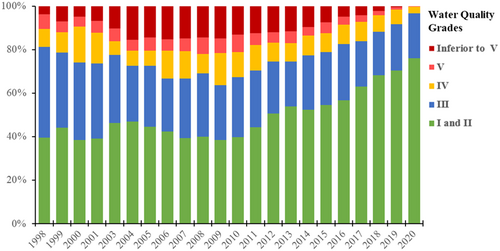
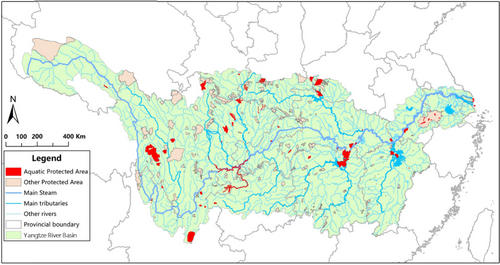
4.2 Fishing bans
To conserve and rationally utilize the fishery resources of the Yangtze River and curb the declining trend of resources, some fishery breeding areas in Jiangsu, Hunan, Hubei, Jiangxi, and other provinces have implemented fishing ban policies since the 1970s. The spring fishing ban policy has been implemented in the main stream of the Yangtze River since 2002, with a duration of 3 months. In 2016, the fishing ban period on the main stream of the Yangtze River was uniformly revised to a duration of 4 months. The spring fishing ban on the Yangtze River had a certain effect in improving species richness and complicating the structure of fish communities (D. Xu et al., 2006; M. Zhang et al., 2006), but the problems of younger and smaller fish are still serious and have not been solved. Meanwhile, although the breeding of broodstock was protected to a certain extent during the fishing ban, fishing intensity was not effectively controlled after the ban was lifted, resulting in severe overfishing, insufficient replenishment, and a decrease in the number of populations. Since the spring fishing ban policy in the Yangtze River has not fundamentally changed the status quo of the reduction of fish resources in the Yangtze River, a 10-year fishing ban was issued in 2020. The scope of the fishing ban has also expanded from the main stream of the Yangtze River to the main stream and important tributaries.
4.3 Artificial proliferation and release
Artificial propagation has played an important role in alleviating the depletion of aquatic biological resources in the Yangtze River Basin. The number of proliferated fry in the Yangtze River Basin has increased year by year (Figure 8), and in 2020 the number was up to 349.4 billion, which was three times the natural fry number in the 1960s (The Investigation Team of Fisheries Resources in the Yangtze River, 1990). At present, the proliferating fish in the Yangtze River Basin includes rare and EN fish such as Chinese sturgeon, Yangtze sturgeon, and mullet, as well as major commercial fishes (Qiao & Guo, 2012). The proliferation and release of Chinese mitten crab seedlings in the Yangtze Estuary is a model for the restoration of fishery resources. The annual catch has increased from less than 1 ton in the late 1990s to more than 60 tons. However, there are still some problems in the management of the artificial breeding and release system, such as blindly pursue the number of releases and do not consider the effectiveness of the release. Although the number of releases is large, due to ineffective supervision and irregular operations, there is a phenomenon of indiscriminate capture, resulting in a low survival rate of the artificial release and the waste of resources (J. Yang et al., 2013). At the same time, a scientific system for evaluating the effect of artificial breeding and the release of fish has not been established (M. Li et al., 2021). The species released are mainly economic fish, but the quality of some released fish has not been strictly controlled and screened. In addition, proliferation technology of many rare and EN fish still needs to be developed and tested, and the effect of the release of Chinese sturgeon and other species with mature proliferation technology is not obvious. The population of Chinese sturgeon juveniles in the Yangtze River Estuary is mainly maintained by natural reproduction. The current scale of artificial breeding and release is far from achieving the protection and restoration of Chinese sturgeon resources (B. Zhu et al., 2009). The subadult Chinese sturgeon individuals released since 2011 have also failed to migrate and spawn.
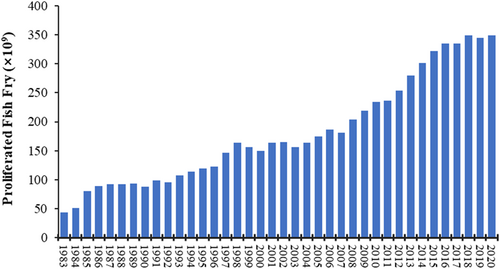
Overfishing since the late 1970s has exacerbated the decrease of fishery resources. Water pollution has also become a serious problem since the late 1980s, especially in lakes isolated from the Yangtze River. Hydraulic constructions such as dams and sluices, as well as the consequent degradation of habitats, have had great impacts, especially since the 2000s. The influences of other human activities such as shipping, shoreline development, and exogenous species introduction, have been rapidly increasing in recent decades. With the implementation of Yangtze River Protection, the increase of pressures on biodiversity tend to slow down. However, the risks of the decline of biodiversity and ecosystem services will still be high.
5 CONCLUSION AND OUTLOOK
The Yangtze River Basin is very rich in aquatic biodiversity, with many rare, EN and endemic species. The Yangtze River Basin has experienced rapid development since the 1950s, and various human activities have deeply affect aquatic biodiversity. Fishing activities have caused significant degeneration of bio-resources and biodiversity. The 10-year fishing ban was issued to avoid further influence, restore fishery resources, and improve the community structure. The effects are worth expecting. Besides, the restoration of fishery resources and biodiversity also require the restoration of habitats, which relies on scientific managements of human activities. The arrangement of 10s of 1000s of fishmen as well as fishing boats is a great challenge for the Chinese government.
Generally, the Yangtze River Basin has gone through a process of “pollution first and then treatment.” With the implementation of the Action Plan for Prevention and Treatment of Water Pollution and other policies, the water quality of the Yangtze River has improved rapidly. However, the pollutants deposited in the sediments of rivers and lakes are still important potential risks for the water ecological security of the basin, especially in the lakes that are isolated from the Yangtze River. Continued attention could be given to the accumulation of pollutants in these lakes and the release of endogenous pollutants to avoid impacts on aquatic organisms and human health.
The water conservancy and hydropower projects in the Yangtze River Basin have contributed greatly on China's social and economic development, although aquatic organisms and aquatic ecosystems have also been affected. At present, more and more remedial measures have been implementing to relieve the influence, for example the establishment of fish passage facilities and the guarantee of ecological water requirement. It is necessary to evaluate the comprehensive benefits of the construction of fishway and other facilities and take the most effective measures. In addition, reservoir regulation should be considering more sensitive species, and multiobjects including power generation, flooding management, and ecological flow and so forth in the future.
Significant breakthroughs have been made in regard to artificial proliferation technology of aquatic organisms in the Yangtze River Basin, which has played an important role in alleviating the depletion of fishery resources and promoting the development of aquaculture. However, these proliferating species can neither cover all affected species, nor can they replace populations in natural habitats, and they cannot change the status quo in which natural populations are still threatened. Unreasonable species placement may also affect the community structure of aquatic organisms. Therefore, artificial proliferation should be combined with ecological restoration. While developing the proliferation technology of rare and EN species, the protection of their existing habitats should be strengthened, and the restoration of damaged habitats should be carried out scientifically.
After decades of research, the understanding of the aquatic biodiversity in the Yangtze River Basin has deepened. At the same time, the understanding of the rapid decline of aquatic biodiversity in the Yangtze River Basin and the desire to slow down and reverse the decline trend are also growing. However, there is still a lack of sufficient understanding of the aquatic biodiversity in the Yangtze River Basin, and comprehensive biodiversity surveys have not yet been carried out in many tributary basins, making it difficult to accurately assess aquatic biodiversity and the threatening factors. The background of aquatic biodiversity should be investigated as soon as possible to better understand the aquatic biodiversity in the Yangtze River Basin, and provide a reference for evaluating the effectiveness of measures such as the protection of the Yangtze River and the 10-year fishing ban.
ACKNOWLEDGMENT
This work was supported by National Science Fund for Distinguished Young Scholars [52025092] and the Beijing Outstanding Youth Funding Project [JQ19034].
ETHICS STATEMENT
None declared.
Open Research
DATA AVAILABILITY STATEMENT
The data that support the findings of this study are available on request from the corresponding author. The data are not publicly available due to privacy or ethical restrictions.



